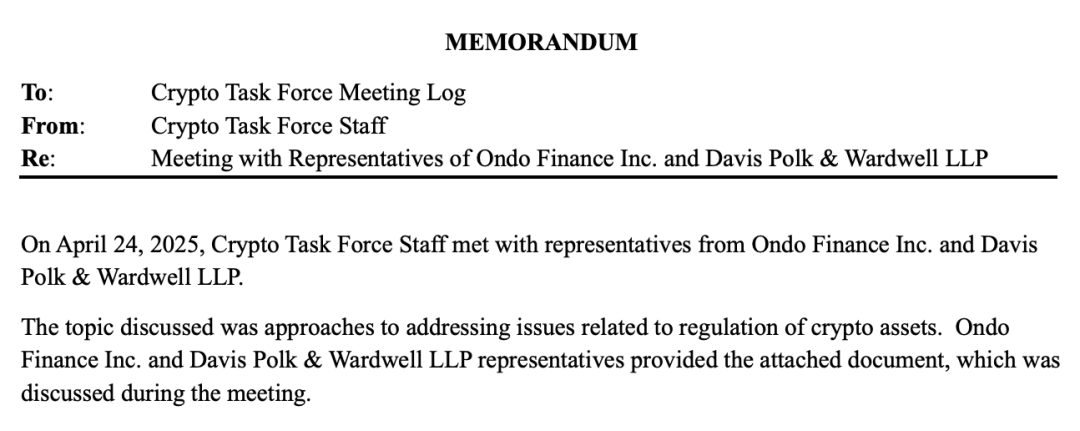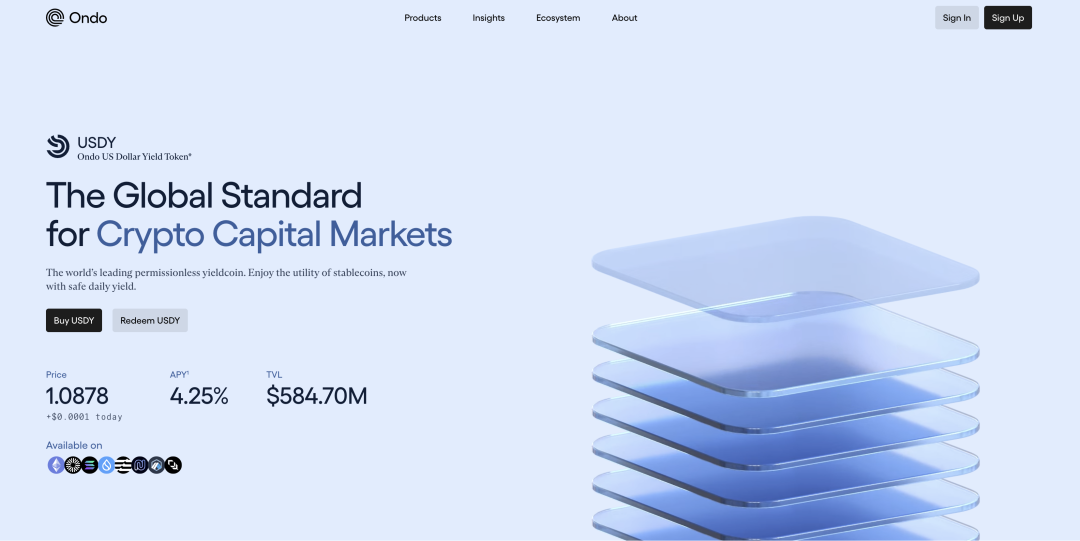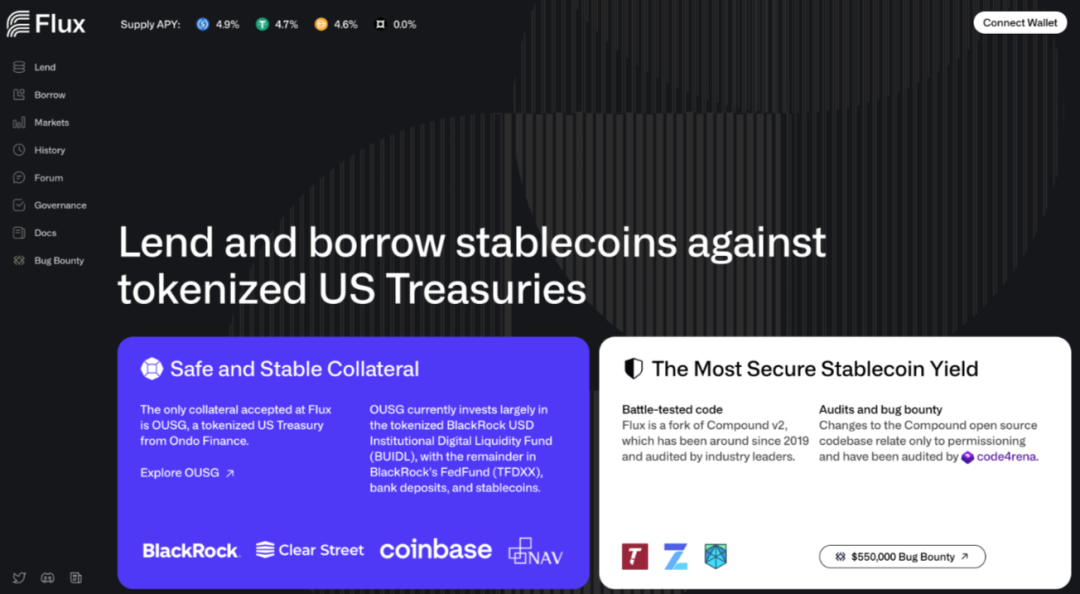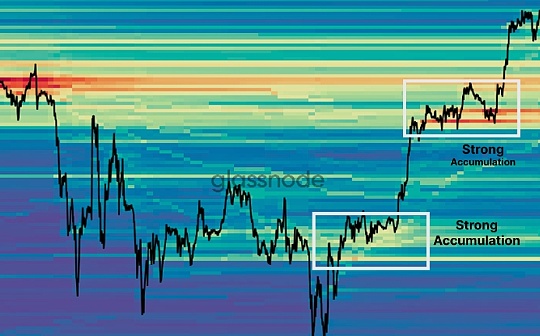Analysis Ondo Finance: How to play RWA in the United States?

Reprinted from panewslab
05/16/2025·21DNow, RWA is really popular.
From the Hong Kong Web3 Carnival in early April to the recent Web3 lawyer circle, everyone is talking about RWA. It’s not unreasonable, after all, RWA is a relatively reliable and safe way to issue coins.
A few days ago, Lawyer Mankun talked to you about China's new RWA projects, such as "Mankun Research | Decoding Mainland China's Characteristics: Practical Characteristics, Risk Analysis and Optimization Path", and also shared with you the current RWA gameplay, such as "Mankun Lawyer | The Split Web3 World, There are at least three RWAs".
However, if we want to talk about RWA's precedent and leader, we have to turn our attention to the United States. The more representative one is probably Ondo. Especially in the past two days, the US Securities and Exchange Commission (SEC) also met with it to discuss the plan to issue tokenized securities in compliance, which really hit a big S on Ondo's report card again.

*Photo source: SEC file screenshot
Therefore, in this article, Lawyer Mankun will talk to you about the gameplay of RWA in the United States based on Ondo's RWA model.
Ondo RWA mode teardown
The reason why Ondo is called the leading RWA project in the industry is that lawyer Mankun believes that the most important thing is that when most projects are still thinking about "what real assets are used to issue coins to raise funds online", Ondo has already brought assets such as US Treasury bonds and money market funds to the chain and integrated them into DeFi gameplay.

Take the token issued by Ondo USDY (Ondo US Dollar Yield Token) for example. The actual assets anchored behind it are short-term US Treasury bonds and bank deposits, which means:
First, the asset has real returns support. USDY is essentially a profit-based stablecoin, and investors can enjoy the benefits brought by US Treasury or bank deposits every day;
Second, transparency and security are guaranteed. The underlying logic of this asset, such as custody, auditing, income distribution, etc., still follows the traditional financial compliance standards.
In addition, USDY adopts a bankruptcy isolation structure, and the reserve assets are completely separated from the issuing entity. Once extreme situations occur, investors have priority claims for reserve assets. In addition to USDY, Ondo also issued OUSG, which anchored US short-term Treasury funds, with a logic similar to USDY.
Therefore, lawyer Mankun believes that to a certain extent, Ondo is more like moving traditional financial financial products and clearing mechanisms to the chain, ensuring that returns and risks are controllable while giving liquidity to the asset chain.
Speaking of asset liquidity, we need to mention another product of the Ondo team, Flux Finance.

If issuing coins is only the first step for RWA, then how to make RWA tokens flow on the chain is the key to value-added. So, Flux Finance - an RWA exclusive lending agreement.
The difference between Flux and common lending agreements (Compound, Aave) is that it allows users to use these tokenized treasury bonds (such as OUSG) as collateral and lend USDC and other stablecoins.
So, the question is: Treasury bonds are 100% securities attributes. Will it touch US regulation in DeFi?
Ondo's solution is the licensing system: not everyone can borrow from OUSG, and they have to pass compliance review to ensure that you are a qualified investor. In other words, through the centralized review system, the disorderly state of "all assets can be mortgaged" in DeFi is avoided, and the on-chain lending activities are also carried out under the compliance framework.
This design is tantamount to setting up a template for the compliance of RWA+DeFi on the overall chain.
In fact, at this point, RWA's gameplay is already a closed loop. However, Ondo is still expanding its territory in the RWA field. Since RWA is so popular, all projects want to do RWA, how to issue and where to circulate? There must be an infrastructure.

Yes, Ondo is not idle at the infrastructure level either. It has built a self-built chain ondo chain, which is specially tailored for RWA. The core gameplay is:
- Licensing verifiers, traditional financial institutions such as Franklin Templeton and WisdomTree as network nodes, ensure network security and compliance;
- In the open application layer, any developer can issue RWA tokens and make dApps on this chain;
- Built-in oracle + cross-chain bridge, the asset price and interest rate data on the chain are directly fed by the verification node.
Such a set of architecture can not only meet the organization's security and supervision requirements, but also ensure the native openness of Web3.
Of course, with infrastructure for everyone to issue coins, the token standards must also be arranged. Therefore, Ondo announced plans to build Ondo Global Markets (Ondo GM) in 2024.

At the beginning, Ondo GM's design was relatively traditional, following the "broker's order model". Tokens represent the holding instructions issued by investors in traditional brokers, and the overall licensing and closed-end style.
However, according to the Ondo blog post in February 2025, after in-depth exchanges with developers, TradFi institutions, and US regulatory officials, Ondo GM is redesigning the tokenization framework to build RWA tokens into a stablecoin. The token itself is free to flow, but the logic of compliance licenses is embedded in the distribution layer. This allows any token issuer to issue compliant and flexible RWA tokens through Ondo GM.
In summary, when others were still studying how to issue RWA assets, Ondo had already developed a set of RWA assets from the traditional financial world to a full-link system on the chain.
Ondo to the US RWA
After talking about Ondo's RWA model, let's raise the next level to see what problems Ondo solves and what progress has promoted the US RWA industry?
Lawyer Mankun believes that we can start from the following two levels:
Market level
In the current industry, many people talk about RWA, and more narratives are at the step of "helping traditional companies issue coins to raise funds." But attorney Mankun believes that the true value of RWA is never just a coin. For high-quality assets, exploring RWA is to allow assets that already have value to obtain higher liquidity opportunities and use efficiency. The threshold is relatively looser than ABS, REITS, etc., and you can use token programmable features to find more combinations of asset activation in the future. .
At this point, Ondo's design sets a standard for the industry.
Whether it is the two RWA tokens it has issued or the Ondo GM it is building, it is building a new financial market that is circulating 7*24 hours a day, minting and redeeming at any time, breaking the traditional financial set of "only opening at work hours".
Of course, circulation is just the first step. Traditional financial products are not inoperable, but their liquidity is often limited to specific times and specific platforms, and the cross-market and cross-asset gameplay is basically locked. Just like you bought gold ETFs and bond funds, although these assets are "flowing" in the account, what can you do? At most, you can wait for the ups and downs, or change the platform and then buy and sell. If you want to participate in the gameplay of lending, income, and derivatives, you basically have no way to go.
Ondo's RWA design breaks these "walls". Especially DeFi gameplay, these tokenized traditional financial assets can be brought into various application scenarios on the chain. To put it bluntly, it is to allow these assets that can only be "earned money" to be reorganized and added on the chain, which may be the real value direction of mining RWA.
Compliance level
The logic at the market level is actually easy to implement, and it is easy to handle with technology and funds. But in the US market, if you want to move securities assets to the chain, compliance is the key threshold, especially in the past few years, the US SEC has been pressing forward step by step.
Therefore, in this context, Ondo will definitely have some explanation for its compliance level.
First of all, when visiting the Ondo platform, lawyer Mankun found that many products cannot be used under the US IP, such as tokens. This means that Ondo avoids the high-pressure areas regulated by the US in product design by actively setting restrictions on US users.
Of course, just blocking US IP is not enough. Because the anchored assets come from the US market, Ondo must strictly follow the US compliance standards in the links directly linked to funds such as custody, auditing, and bankruptcy isolation, even if it comes from overseas for users. Therefore, Ondo has taken measures such as custodying assets in trust institutions regulated by the United States (such as Ankura Trust), strictly licensing and qualification review of lending methods, designing bankruptcy isolation mechanisms, and protecting investors' priority claim rights.
But the question is, if there is an overseas market, what should the US market do?
In 2025, Ondo and Davis Polk Law Firm negotiated with the US SEC on compliance with tokenized securities, so there was a "wrapped securities token" solution mentioned by lawyer Mankun, which was to explore paths such as registration exemption and market structure exemption through the distribution layer, trying to make tokenized securities find legal implementation in the US market.
In other words, on the one hand, Ondo uses its existing compliance framework to steadily break through the non-US market; on the other hand, it actively talks with the US regulatory dialogue, trying to find out the possibility of RWA asset compliance implementation in a high-pressure environment.
Mankun lawyer's practical advice
After talking so much, let’s go back to the most critical question: How to play the American RWA?
Lawyer Mankun’s advice is: Don’t fantasize that one step is in place, avoid + explore, balance + step by step, the most realistic way of playing:
First, the market does not lack products, what is lacking is a "way to survive". The US securities market is large in size and high in asset quality, which is indeed an ideal pool for RWA. However, regulatory barriers are also high. From securities laws, market structures, to brokers and anti-money laundering, every link is a "mine zone". Although the crypto-friendly SEC chairman is on the stage now, no one knows where the regulatory direction will turn next. Therefore, it is better to implement the non-US market first, and ensure that the asset side complies with supervision.
Second, you want to learn to design more ways to play, but you should also pay attention to the boundaries. Especially DeFi gameplay is very rich, but in the US market, the more fancy the gameplay, the more sensitive the supervision. In addition, don’t always think about the decentralization path. As it turns out, if you want to comply, you still need centralized participation, especially high-risk scenarios such as lending and derivatives. The centralized restrictions make the gameplay safer and more transparent.
Third, talk more with supervision and pave the way ahead. Don't think about going around, you can't go around. The US market supervision is strong. If you want to grow bigger, you must have your own compliance layout, including cooperating with law firms in advance, or forming your own legal team, actively talking with the US SEC, and exploring compliance paths.
In short, dig the two moats of market and compliance first, and then slowly find a way to make breakthroughs, and don’t think about becoming fat in one bite.


 jinse
jinse

 chaincatcher
chaincatcher